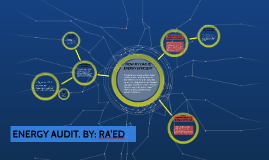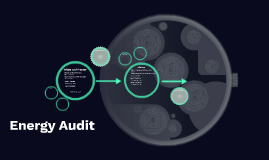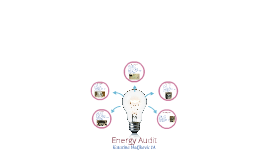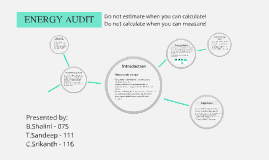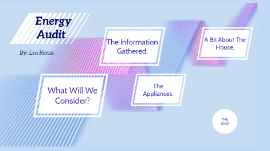Energy Audit
Transcript: This Energy Audit is used to find our weak spots in energy conservation. Using the information I gathered, We are using too much electricity and water. Along with a low electricity efficiency, our outdated appliances also use up more water. Our dishwasher alone uses up to 10 gallons per load, while newer ones use as few as 3 gallons. If we use too much water, we will get charged more for water bills, and lead to us being unable to buy more electrically efficient appliances. Transportation How We Fix The Going Where The Money Goes Solutions There are many solutions to completing this, but very many cannot be done comfortably. We would be required to cut back on electrical usage considerably, which would mean having to buy more energy efficient appliances. This would put strain on our money in the short term, but will eventually save that money in the long term. However, electricity is not the only thing that we waste energy with. We also use almost 1.5 times the average water consumption in the USA. In order to fix that problem, we would need to upgrade appliances, such as our dishwasher and toilets, to energy efficient models. However, even though it is not the most pressing matter, we can still afford to cut back on other usages such as waste and transportation. The good news is, is that we do not produce that much solid waste. We recycle nearly all of what we can, and reuse many things. This, in turn, allocates more space in landfills for others, and less strain on the environment. However, we still consume much as a family, leading to a baseline amount of trash we can't decrease past. If we were to cut down on what we took in, there wouldn't be as much that came out. How Will We Go Introduction Our biggest source of energetic waste is our overuse of electricity. Our computers run all day, our phones are constantly charging, and we are still constantly using halogen lightbulbs throughout the house. These factors pile up, and waste electricity on useless things, such as lighting an empty room, or a computer that nobody is using. It's not just the fact that nobody turns things off that wastes energy however. Our appliances are also inefficient, and terribly out of date. However, there are ways to fix these problems. We need to upgrade our home appliances to newer energy efficient ones, and possibly reduce the use of technology such as computers and phones. With these changes we'll be able to save immense amounts of energy per year, and waste less energy altogether Where All Of Our Stuff Goes How We Go Electricity In conclusion, we will need to begin to replace our appliances one at a time over the next few years or so, as we would need to save money to buy these for a while. Yet, even though we use a higher than average rate of electricity and water, we are still rather energy efficient, as we recycle almost everything, and produce very little trash for landfills. We are a very efficient family with inefficient tools. Our household produces 22 TONS of Carbon Dioxide a year. If everyone on Earth lived the same way we did, we would need 4.6 Earths to support our needs. We need to change this. Energy Audit Reflection Waste Where The Energy Goes Water Unfortunately, our cars have a very, very low fuel efficiency. Our trusty old Jeep and Honda only get about 12 miles per gallon of fuel. This is not the worst fuel efficiency of cars on the road right now, but it is nowhere near efficient. With most cars nowadays get around 25-30 miles per gallon, and hybrids getting up to 60, our cars have been seriously outdated. Yet, the cost of buying a brand new car is rather expensive, so I will not force you to buy one or two. However, we can still cut back on emissions by driving less throughout the year, and using up to date methods of navigation so we don't waste fuel by getting lost. Throughout this presentation, I have listed many different solutions to our energy conservation problem. However, the most viable and affordable would be to slowly replace all of our inefficient appliances, and upgrade to top of the line products. This way, we can start saving money on our electric bill, and putting less strain on the environment at the same time. This idea will also work to cut back on the water necessary to use some appliances like our dishwasher or washing machine. Conclusion This project went over well with my family. They agreed to help implement my ideas and begin to be more efficient as a whole. They enjoyed the presentation and thought I did well. From a professional view, I believe they made the right decision. They're opting for a cheaper and more environmentally friendly lifestyle, and I'm all for that. From an objective standpoint, I think they made a very smart choice, as they will save money and resources. From an economical standpoint, they will be coming out better than going in, as they will not have to spend as much on electricity and water.






